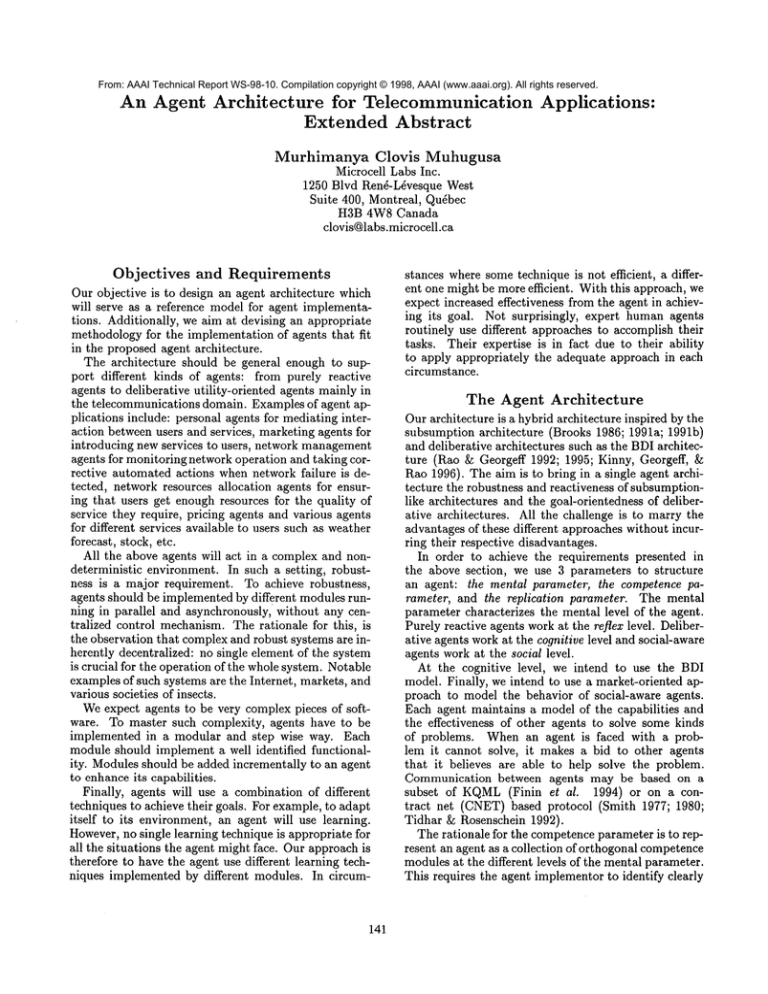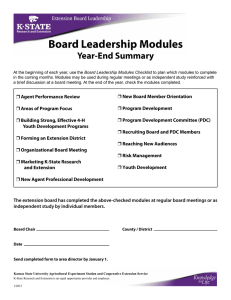
From: AAAI Technical Report WS-98-10. Compilation copyright © 1998, AAAI (www.aaai.org). All rights reserved.
An Agent Architecture
for Telecommunication
Extended Abstract
Applications:
Murhimanya
Clovis
Muhugusa
Microcell Labs Inc.
1250 Blvd Ren~-L~vesque West
Suite 400, Montreal, Quebec
H3B 4W8 Canada
clovis@labs.microcell.ca
Objectives
and Requirements
Our objective is to design an agent architecture which
will serve as a reference model for agent implementations. Additionally, we aim at devising an appropriate
methodology for the implementation of agents that fit
in the proposed agent architecture.
The architecture should be general enough to support different kinds of agents: from purely reactive
agents to deliberative utility-oriented agents mainly in
the telecommunications domain. Examples of agent applications include: personal agents for mediating interaction between users and services, marketing agents for
introducing new services to users, network management
agents for monitoring network operation and taking corrective automated actions when network failure is detected, network resources allocation agents for ensuring that users get enough resources for the quality of
service they require, pricing agents and various agents
for different services available to users such as weather
forecast, stock, etc.
All the above agents will act in a complex and nondeterministic environment. In such a setting, robustness is a major requirement. To achieve robustness,
agents should be implemented by different modules running in parallel and asynchronously, without any centralized control mechanism. The rationale for this, is
the observation that complex and robust systems are inherently decentralized: no single element of the system
is crucial for the operation of the whole system. Notable
examples of such systems are the Internet, markets, and
various societies of insects.
Weexpect agents to be very complex pieces of software. To master such complexity, agents have to be
implemented in a modular and step wise way. Each
module should implement a well identified functionality. Modules should be added incrementally to an agent
to enhance its capabilities.
Finally, agents will use a combination of different
techniques to achieve their goals. For example, to adapt
itself to its environment, an agent will use learning.
However,no single learning technique is appropriate for
all the situations the agent might face. Our approach is
therefore to have the agent use different learning techniques implemented by different modules. In circum-
141
stances where some technique is not efficient, a different one might be more efficient. With this approach, we
expect increased effectiveness from the agent in achieving its goal. Not surprisingly,
expert human agents
routinely use different approaches to accomplish their
tasks. Their expertise is in fact due to their ability
to apply appropriately the adequate approach in each
circumstance.
The Agent Architecture
Our architecture is a hybrid architecture inspired by the
subsumption architecture (Brooks 1986; 1991a; 1991b)
and deliberative architectures such as the BDIarchitecture (Rao ~ Georgeff 1992; 1995; Kinny, Georgeff,
Rao 1996). The aim is to bring in a single agent architecture the robustness and reactiveness of subsumptionlike architectures and the goal-orientedness of deliberative architectures. All the challenge is to marry the
advantages of these different approaches without incurring their respective disadvantages.
In order to achieve the requirements presented in
the above section, we use 3 parameters to structure
an agent: the mental parameter, the competence parameter, and the replication parameter. The mental
parameter characterizes the mental level of the agent.
Purely reactive agents work at the reflex level. Deliberative agents work at the cognitive level and social-aware
agents work at the social level.
At the cognitive level, we intend to use the BDI
model. Finally, we intend to use a market-oriented approach to model the behavior of social-aware agents.
Each agent maintains a model of the capabilities and
the effectiveness of other agents to solve some kinds
of problems. When an agent is faced with a problem it cannot solve, it makes a bid to other agents
that it believes are able to help solve the problem.
Communication between agents may be based on a
subset of KQML(Finin et al. 1994) or on a contract net (CNET) based protocol (Smith 1977; 1980;
Tidhar & Rosenschein 1992).
The rationale for the competenceparameter is to represent an agent as a collection of orthogonal competence
modulesat the different levels of the mental parameter.
This requires the agent implementor to identify clearly
different orthogonal functionalities that will determine
the agent behavior. In this way, functionality may be
added incrementally to an agent. Finally, the replication parameter reflects the fact that different functional
modulesof an agent will provide the same functionality
using different strategies and techniques.
Prototype implementations will serve to identify
functionality needed by different kinds of agents. Such
functionality will be implemented by various competence modules that may be reused in the implementation of other agents. In the long term, we expect to
have a ’toolkit’ of competence modules which can be
combined in various ways to build other agents.
To achieve robustness, interaction between the different modules composing an agent must occur asynchronously. Weintend to use for this an asynchronous
message queueing mechanism. Modules will dynamically subscribe/unsubscribe for messages originating
from other modules. This defines a kind of network
through which information flows in the agent. In this
way, functional modulescreate dynamic affinity links in
the agent. This results in a flexible architecture because
the agent’s architecture is determined not only by the
functional modules that compose the agent, but also by
the affinities between them.
High-level mechanismsfor coordination, cooperation
and conflict resolution among modules will be implemented on top of the asynchronous messaging system.
In fact, if one considers agent functional modules as
agents with limited capability, the proposed architecture advocates to structure a single agent as a ’multiagent system’. Like a multi-agent system, the behavior
of the agent ’emerges’ as the result of its functional
modules. And like a multi-agent system, our architecture must address the issues of coordination between
functional modules. Dealing with these issues at the
agent level will result in more insight and more experience which will be valuable when we will address multiagent issues. The architecture may therefore be used
as a commonand unified framework for designing both
agents and multi-agent systems.
Implementation
Environment
The best way to implement concurrency among functional modules is to implement an agent as a multithreaded process with each functional module being
a separate thread. The multi-threaded approach allows concurrency while providing efficient communication mechanisms between threads.
The development of a complex agent application consists of two related tasks, namely, knowledgeengineering and the design and implementation of different processes such as modelling, learning, planning and reasoning, that use the knowledgeto achieve rational behavior. The way these processes are implemented depends on the type of knowledgeand its representation.
Thus, the environment must support different knowledge representation schemes. Furthermore, the environment should allow the agent implementor to engi-
142
neer the agent knowledge in a modular and step-wise
approach similar to that used for the agent’s functional
modules. Additionally, to support modularity and software reuse, an object-oriented approach is highly desirable.
Finally, support for mobility is interesting due to the
foreseen kinds of applications. This requires effective
solutions to security issues inherent to agent mobility.
References
Brooks, R. A. 1986. A Robust Layered Control System
for a Mobile Robot. IEEE Journal of Robotics and
Automation 2(1):14-23.
Brooks, R. A. 1991a. Intelligence Without Reason. In
Proceedings of the Twelfth International Joint Conference on Artificial Intelligence (IJCAI-91), 569-595.
Brooks, R. A. 1991b. Intelligence Without Representation. Artificial Intelligence (47):139-159.
Finin, T.; Fritzon, R.; McKay, D.; and McEntire,
R. 1994. KQMLas an Agent Communication Language. In Proceedings of the Third International Conference on Information and Knowledge Management
(CIKM’94). ACMPress.
Kinny, D.; Georgeff, M. P.; and Rao, A. S. 1996. A
Methodology and Modelling Technique for Systems of
BDI Agents. In van der Velde, W., and Perram, J. W.,
eds., Proceedings of the Seventh European Workshop
on Modelling Autonomous Agents in a Multi-Agent
World, MAAMAW’96,volume 1038 of Lecture Notes
in AI (LNAI), 56-71. Springer Verlag.
Rao, A. S., and Georgeff, M. P. 1992. Modelling
Rational Agents within a BDI-architecture. In Allen,
J.; Fikes, R.; and Sandewall, E., eds., Proceedings of
the Second International Conference on Principles of
Knowledge Representation and Reasoning. San Mateo,
CA: Morgan Kaufmann.
Rao, A. S., and Georgeff, M. P. 1995. BDI Agents:
From Theory to Practice.
In Proceedings of the
First International Conference on Multi-Agent Systems (ICMAS-95). San Francisco, CA: AAAI Press
/ The MIT Press.
Smith, R. G. 1977. The contract net: A formalism
for the control of distributed problem solving. In Proceedings of the Fifth International Joint Conference on
Artificial Intelligence (IJCAI- 77).
Smith, R. G. 1980. The Contract Net Protocol. IEEE
Transactions on Computers C-29(12).
Tidhar, G., and Rosenschein, J. 1992. A Contract
Net with Consultants. In Proceedings of the Tenth
EuropeanConference on Artificial Intelligence (ECAI92), 219-223.




